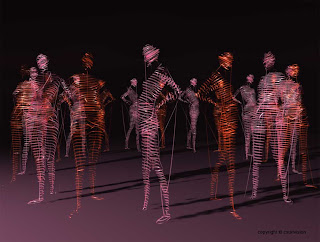- Two planar forms have the ability to interact with each other in three different ways. The first is they can meet at a common edge, such as a fold. The second is that one edge of a plane can abut or be adjacent to the face of another. The third is that the two planes can interpenetrate, or pass through one another.
- The three plane rule is "a stable structure results when any three planes meet so that each plane interacts with both of the other planes."
Robert Murray, Wasahaban, painted aluminum. 1978.
- An environmental plane defines a space in which the planar object is experienced.
- The combination to make one unified structure is the planar structure.
Bohlin Cywinski Architects, Modern Suburban House. 2010.
These forms are often found in furniture and architecture. Their features include:
- Geometric shapes such as rectangles, triangles, and circles.
- Primary emphasis on horizontal and vertical orientations as well as orthogonal placements.
- Contrast of closed (interior) and open (exterior) space with emphasis on these two types of space.
Arnolfo di Cambio / Filippo Brunelleschi, Basilica di Santa Maria del Fiore. Florence, Italy, 1436.
Note the use of geometric shapes, emphasis on horizontals and verticals,
and the contrast of interior and exteriors, especially in the windows.
4. How can a reflective surface effect the transition of space?
- Reflective surfaces create an illusion of space entering into a closed surface, therefore they possess the ability to effect the transition of space.
Anish Kapoor, Cloud Gate, steel. Chicago, USA, 2004-06.
- Planes define volume by their virtue or shape, such as many intersecting circles of the same shape with the same center set at different angles make a sphere.
Sphere shown with intersecting planes which make up the volume
6. Describe the following organizational principles that relate to 3 dimensional forms:
1. Organization-
- The overall structure or pattern which combines parts of an object together into a united, sensible, and purposeful whole. A design's organization derives from its purposes, meanings, and functions of its overall intention.
Charles A. Csuri, The Frozen Moment, virtual glass. 1999-2001.
- Derives from the organization of separately unimpressive elements which join to create an outcome greater than expected.
Casey Vidalenc, Synergy in Fashion, interwoven strings and ropes. 2011.
- In design, there needs to be a balance between order and freedom to create unity and richness in a composition. It is necessary to think about which one to choose to emphasize to achieve success in the composition.
Numen / For Use Collective, Tape Melbourne, mixed materials. Melbourne, Australia, 2011.
- The effective use of unified principles help to create a systematic structure. These principles which include balance, repetition with variety, proportion, continuity, focus and emphasis, and economy visually bind together a composition.
Jürgen Mayer-Hermann, Metropol Parasol, wood. Seville, Spain, 2005-2011.
- Bilateral (mirrored) is the most common type of symmetry and is when one half of a composition is reflected either horizontally or vertically in the other half.
Ustad Ahmad Lahauri, Taj Mahal. Agra, India, 1632-1653.
- Radial symmetry relates to the use of repeated forms that radiate from a central axis.
John Augustus Roebling, The Brooklyn Bridge. New York, USA, 1883.
6. Repetition within variety
- Repetition produces order in a composition, but having an excessive amount creates blandness. Therefore variety must be present to keep the viewer's attention. Strong unity within a design derives from repeating compositional elements of specific relationships.
Akio Hizume, Fibonacci Tunnel, bamboo. Tokyo, Japan, 2008.
- Along with variety, these two forms use the systematic repetitions of intervals of change.
Daniel Rozen, Circles Mirror, digitally printed circles with motors and other electronics. 2005.
Source: Leucking, Steven. Principles of Three-Dimensional Design: Objects, Space, and Meaning













No comments:
Post a Comment